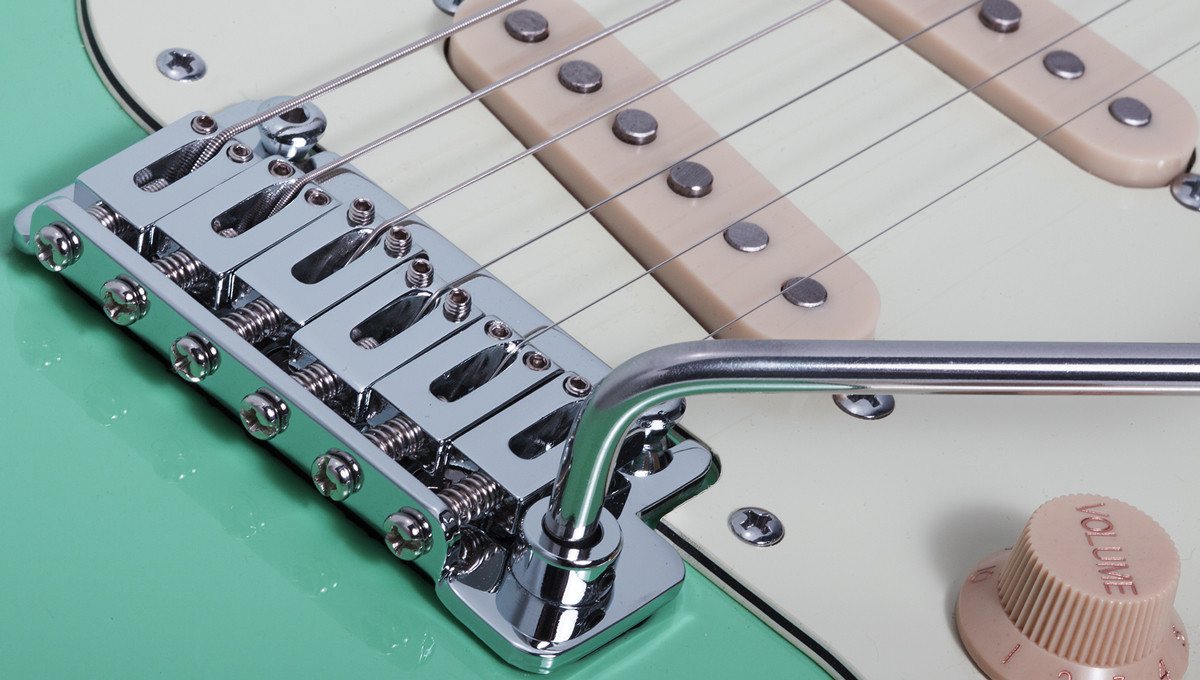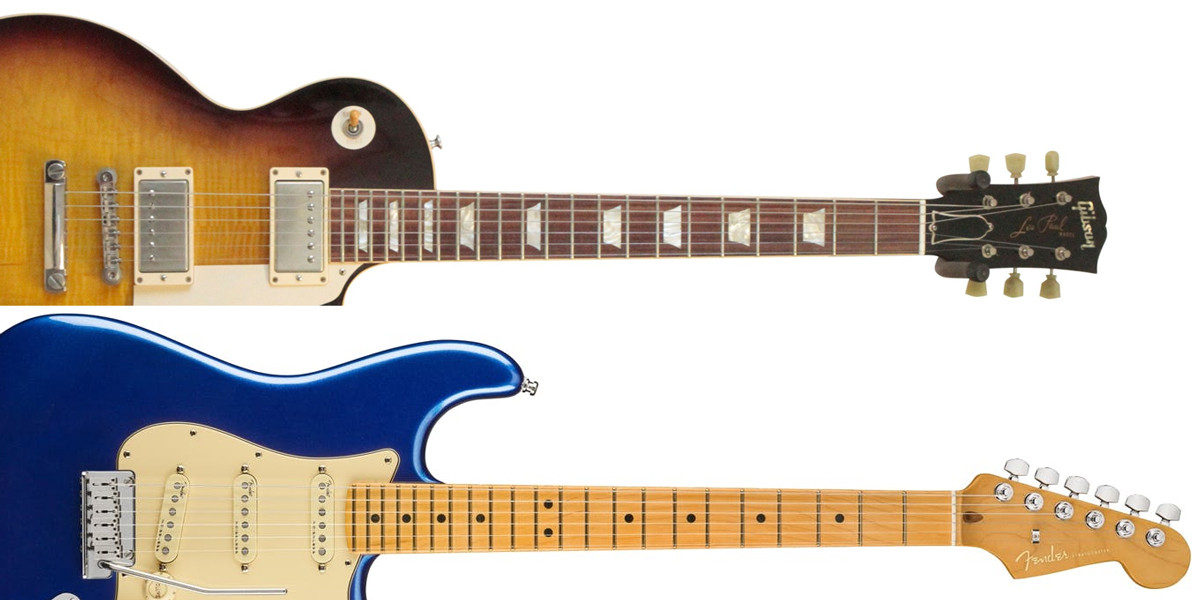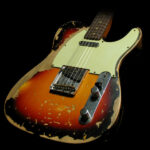How Do You Measure Scale Length On A Guitar? Scale length is a crucial spec influencing playability and tone, and at guitarplayers.net, we’re dedicated to helping guitarists of all levels understand its importance. This article provides an in-depth guide to measuring guitar scale length, exploring its impact on your instrument, and helping you choose the perfect guitar. Join us as we demystify scale length and empower you to make informed decisions about your musical journey.
1. What Does Guitar Scale Length Really Mean?
Guitar scale length is defined as the distance from the guitar’s nut to its bridge. Essentially, it’s the vibrating length of the strings that produces sound. It dictates the spacing between frets and significantly influences string tension and overall playability. Understanding scale length is vital for any guitarist seeking to optimize their instrument for comfort and tone.
1.1 Why Is the Nut-to-Bridge Distance Important?
The nut-to-bridge distance, or scale length, determines the guitar’s intonation, string tension, and overall feel. According to research from the Berklee College of Music, a longer scale length typically results in higher string tension, leading to a brighter tone and tighter feel, while a shorter scale length provides a warmer tone and looser feel. It’s a fundamental element that affects how the guitar responds to your playing style.
1.2 How Does Scale Length Affect String Vibration?
Scale length directly impacts how strings vibrate; longer scale lengths produce tighter, more focused vibrations, while shorter scales allow for looser, more resonant vibrations. This characteristic shapes the guitar’s tonal output, influencing its suitability for various genres and playing techniques. Understanding this dynamic helps guitarists select instruments that complement their musical preferences.
2. How Do You Measure the Scale Length of a Guitar Step-By-Step?
You can measure the scale length of a guitar using a measuring tape or ruler by measuring from the nut to the center of the 12th fret, and doubling that measurement. This method provides a close approximation of the guitar’s scale length, essential for understanding its playability and tone. This approach is the industry standard for quickly determining scale length.
2.1 Tools You’ll Need for Accurate Measurement
For accurate scale length measurement, gather a precise measuring tape or ruler, preferably in inches, and ensure your guitar is properly strung and tuned. Good lighting and a stable surface are also crucial. Having the right tools ensures accurate measurements, leading to a better understanding of your guitar’s specifications.
2.2 Step-by-Step Guide to Measuring Like a Pro
- Position Your Guitar: Place the guitar on a flat, stable surface.
- Locate the Nut: Find the nut, the small piece at the headstock where the strings rest.
- Measure to the 12th Fret: Measure the distance from the nut to the center of the 12th fret with your measuring tape or ruler.
- Double the Measurement: Multiply this measurement by two to find the total scale length.
- Record the Scale Length: Note down the measurement in inches, as this is the standard unit for guitar scale lengths.
2.3 Common Mistakes to Avoid While Measuring
Avoid measuring from the front edge of the nut, which can add extra length. Always measure from the point where the strings make contact. Ensure the measuring tape is straight, not curved, to avoid inaccurate readings. Double-check your measurements to rule out any errors.
 Measuring Guitar Scale Length
Measuring Guitar Scale Length
3. Why Is the Scale Length of a Guitar Considered Important?
The scale length of a guitar is important because it significantly influences playability, string tension, and tone. A longer scale length generally leads to a brighter, more articulate sound with higher string tension, while a shorter scale length offers a warmer, more mellow tone with lower string tension. Understanding the impact of scale length is crucial for selecting a guitar that suits your playing style and tonal preferences.
3.1 How Scale Length Affects Intonation
Scale length directly affects intonation, the accuracy of pitch across the fretboard. Longer scale lengths can improve intonation, especially on lower tunings, while shorter scales may require more precise setup to maintain accurate intonation. Properly set intonation ensures that the notes you play are in tune, contributing to a professional sound.
3.2 The Role of Scale Length in String Tension
Scale length is a key factor in determining string tension; longer scales increase tension, making strings feel tighter and requiring more effort to bend, while shorter scales reduce tension, making strings feel slinkier and easier to bend. This interplay between scale length and string tension impacts playability and comfort.
3.3 Impact on Overall Guitar Playability
Scale length affects overall playability by influencing fret spacing and string tension. Shorter scales have closer frets and lower tension, making them ideal for players with smaller hands, while longer scales offer more room for complex fingerings and greater note clarity. The choice of scale length can significantly impact a guitarist’s comfort and performance.
4. How Does Guitar Scale Length Impact Playability and Tone?
Guitar scale length influences both playability and tone by affecting string tension, fret spacing, and harmonic content. Longer scale lengths increase string tension and brightness, while shorter scales offer easier playability and warmer tones. The interplay of these factors determines how a guitar feels and sounds, making scale length a critical consideration for guitarists.
4.1 Playability: String Bending Made Easy
Shorter scale lengths make string bending easier due to lower string tension, while longer scales require more finger strength. According to a study by Guitar World Magazine, many blues and rock guitarists prefer shorter scale guitars because they allow for effortless bends and vibrato. The ease of string bending can greatly enhance a player’s expression and technique.
4.2 Playability: Fret Spacing and Hand Size Considerations
Fret spacing, which is influenced by scale length, affects playability and comfort, especially for guitarists with different hand sizes. Closer fret spacing on shorter scale guitars suits players with smaller hands, while wider spacing on longer scales provides more room for complex chords and fingerings. The right fret spacing can improve dexterity and reduce fatigue.
4.3 Tone: Brightness vs. Warmth
Scale length influences a guitar’s tonal characteristics, with longer scales producing brighter, more articulate sounds, and shorter scales offering warmer, more rounded tones. A longer scale emphasizes higher frequencies, while a shorter scale enhances the lower end, making scale length a crucial factor in shaping a guitar’s voice.
5. Which String Gauges Work Best with Specific Guitar Scale Lengths?
Matching string gauge to guitar scale length is essential for optimal playability and tone. Lighter gauges are well-suited for shorter scale lengths to maintain comfortable tension, while heavier gauges complement longer scales by providing necessary resistance and clarity. Proper string gauge selection ensures the guitar feels balanced and sounds its best.
5.1 Finding the Right Balance: Tension and Tone
Finding the right balance between string tension and tone involves considering both scale length and string gauge. A lighter gauge on a longer scale can produce a thin, weak tone, while a heavier gauge on a shorter scale may feel stiff and difficult to play. Experimenting with different gauges helps find the ideal balance for your instrument.
5.2 Recommended String Gauges for Common Scale Lengths
Here are recommended string gauges for common scale lengths:
| Scale Length (Inches) | Recommended String Gauge |
|---|---|
| 24″ | .009 – .042 |
| 24.75″ | .010 – .046 |
| 25.5″ | .010 – .046 or .011 – .048 |
| 27″ | .011 – .054 |
These recommendations provide a starting point for optimizing string tension and tone on different scale lengths, allowing guitarists to fine-tune their setup to personal preferences.
5.3 How String Material Affects the Equation
String material influences the overall tension and tonal characteristics, where nickel-plated steel offers a balanced tone and comfortable feel. Pure nickel provides a warmer, vintage tone with a softer touch. Stainless steel strings produce a brighter, more aggressive sound with increased durability. Understanding the nuances of string material can further refine the guitar’s playability and sound.
6. Common Guitar Scale Lengths: An Overview
Common guitar scale lengths range from 24 inches to 27 inches, each offering distinct playability and tonal characteristics. Understanding these differences helps guitarists choose the right instrument for their needs. Each scale length has unique benefits and applications, so it’s important to know your preferences before selecting an instrument.
6.1 Fender vs. Gibson: Iconic Scale Length Differences
Fender guitars typically feature a 25.5-inch scale length, while Gibson guitars usually have a 24.75-inch scale length, resulting in distinct tonal and playability differences. The longer scale of Fenders contributes to a brighter, snappier tone, while the shorter scale of Gibsons produces a warmer, more rounded sound. These iconic differences have shaped the landscape of guitar music for decades.
6.2 Scale Length and Guitar Types: Matching Instruments to Your Style
Scale length and guitar types:
| Guitar Type | Typical Scale Length (Inches) | Ideal For |
|---|---|---|
| Stratocaster | 25.5 | Rock, Blues, Pop |
| Les Paul | 24.75 | Rock, Blues, Jazz |
| Acoustic Guitar | 25.4 | Folk, Country, Fingerstyle |
| Baritone Guitar | 27 – 30 | Metal, Djent, Extended Range |
Matching instruments to playing styles ensures optimal performance and comfort.
6.3 Beyond the Standard: Baritone and Multi-Scale Guitars
Baritone guitars feature longer scale lengths, typically 27 inches or more, allowing for lower tunings without sacrificing string tension, while multi-scale guitars combine different scale lengths to optimize tension across all strings. These innovative designs cater to specialized playing styles and tonal requirements.
7. Scale Length and Tuning Stability: What’s the Connection?
Scale length impacts tuning stability due to its influence on string tension; longer scales generally offer better stability because higher tension keeps strings firmly in place, while shorter scales may require more frequent tuning adjustments. Understanding this connection is crucial for guitarists who rely on consistent pitch and intonation. Proper setup and string selection can further enhance tuning stability.
7.1 Maximizing Stability on Different Scale Lengths
To maximize tuning stability, consider the following for different scale lengths:
- Longer Scales: Use heavier gauge strings to maintain high tension.
- Shorter Scales: Ensure proper nut and bridge setup to prevent string slippage.
Following these guidelines ensures reliable tuning across various instruments, allowing guitarists to focus on their performance without worrying about pitch drifting.
7.2 The Role of Nut and Bridge Materials
The nut and bridge materials influence tuning stability by affecting how strings move and vibrate; bone and graphite nuts reduce friction, preventing strings from binding and causing tuning issues, while high-quality bridge saddles ensure consistent string contact. Upgrading these components can significantly improve tuning stability.
7.3 When to Consider Locking Tuners
Locking tuners enhance tuning stability by securing the strings tightly, reducing slippage and minimizing the need for frequent adjustments. They are particularly useful for guitars with vibrato systems or those subjected to heavy playing. Investing in locking tuners can improve the reliability and consistency of your instrument.
8. Maintenance Tips for Different Scale Lengths
Maintaining guitars with different scale lengths involves specific considerations to ensure optimal playability and longevity; longer scales may require more frequent neck adjustments due to higher string tension, while shorter scales benefit from careful setup to prevent string buzz. Tailoring maintenance routines to each scale length can prolong the life of the instrument and preserve its performance.
8.1 Cleaning and Conditioning: What’s Best for Your Fretboard
Regular cleaning and conditioning are vital for maintaining the fretboard; lemon oil or specialized fretboard conditioners prevent dryness and cracking on rosewood and ebony fretboards, while maple fretboards benefit from occasional cleaning to remove dirt and grime. Proper fretboard care keeps the guitar playing smoothly and looking its best.
8.2 Adjusting Action and Intonation: Tailoring to Your Preferences
Adjusting action and intonation is essential for customizing the feel and sound of your guitar; lower action makes playing easier, while proper intonation ensures accurate pitch across the fretboard. Tailoring these adjustments to your playing style and scale length can greatly enhance comfort and performance.
8.3 Seasonal Considerations: Humidity and Temperature Effects
Seasonal changes in humidity and temperature can affect guitar necks, causing them to warp or bow; maintaining consistent humidity levels between 45% and 55% prevents these issues. Storing the guitar in a controlled environment ensures it remains stable and playable year-round.
9. Demystifying Guitar Specs: Beyond Scale Length
Guitar specs encompass more than just scale length, including tonewoods, pickups, and hardware, all of which contribute to the instrument’s overall sound and feel. Understanding these elements helps guitarists make informed decisions when selecting a guitar. Combining knowledge of scale length with these other factors provides a comprehensive view of the instrument’s capabilities.
9.1 Tonewoods: How They Interact with Scale Length
Tonewoods interact with scale length to shape the guitar’s tonal characteristics; mahogany bodies paired with shorter scales produce warm, resonant tones, while maple bodies combined with longer scales offer bright, articulate sounds. The interplay between tonewoods and scale length creates a wide range of sonic possibilities.
9.2 Pickups: Voicing Your Instrument
Pickups play a crucial role in voicing the instrument; single-coil pickups on longer scale guitars provide bright, crisp tones, while humbucker pickups on shorter scale guitars deliver thick, powerful sounds. Selecting the right pickups can greatly enhance the guitar’s suitability for various genres and playing styles.
9.3 Hardware: Bridges, Tuners, and More
Hardware components, such as bridges and tuners, affect playability and tuning stability; high-quality bridges ensure proper intonation and sustain, while reliable tuners prevent slippage and maintain consistent pitch. Upgrading hardware can improve the overall performance and reliability of the guitar.
10. Scale Length and Genre: Finding Your Perfect Match
Scale length and genre are interconnected, with certain scale lengths being favored for specific musical styles; longer scales are popular for rock and metal due to their bright, articulate tones, while shorter scales are often preferred for blues and jazz because of their warm, mellow sounds. Matching scale length to genre can enhance the instrument’s suitability for your musical expression.
10.1 Rock and Metal: Longer Scales for Articulation
Longer scales, such as 25.5 inches, offer the articulation and clarity needed for complex rock and metal riffs, providing tight, focused tones that cut through the mix. These scale lengths are ideal for aggressive playing styles and high-gain applications.
10.2 Blues and Jazz: Shorter Scales for Warmth
Shorter scales, like 24.75 inches, provide the warmth and sustain favored by blues and jazz guitarists, offering smooth, rounded tones that are perfect for soulful solos and chord melodies. These scale lengths are ideal for expressive playing styles and nuanced performances.
10.3 Acoustic Styles: Finding the Right Resonance
Acoustic styles benefit from finding the right resonance, with scale lengths around 25.4 inches striking a balance between warmth and clarity, offering versatile tones suitable for fingerstyle, strumming, and flatpicking. These scale lengths are popular for their balanced sound and comfortable playability.
 Fender Stratocaster vs Gibson Les Paul
Fender Stratocaster vs Gibson Les Paul
FAQ: Common Questions About Guitar Scale Length
1. Is a longer or shorter scale length better for beginners?
A shorter scale length is generally better for beginners because it offers easier playability and reduced string tension.
2. Does scale length affect the price of a guitar?
Yes, scale length can affect the price of a guitar, with specialized scale lengths like baritone or multi-scale often costing more due to complexity.
3. Can I change the scale length of my guitar?
No, you cannot change the scale length of your guitar as it is a fixed aspect of the instrument’s construction.
4. How does scale length affect drop tunings?
Longer scale lengths provide better string tension and clarity in drop tunings, preventing the strings from feeling too loose.
5. What is the scale length of a 7-string guitar?
The scale length of a 7-string guitar typically ranges from 25.5 to 27 inches, with longer scales offering better low-end clarity.
6. Are there any guitars with adjustable scale lengths?
No, there are no guitars with adjustable scale lengths, as the scale length is a fixed part of the guitar’s design.
7. How do I choose the right scale length for my guitar?
Choose the right scale length for your guitar by considering your playing style, hand size, and preferred tone, experimenting to find what feels most comfortable.
8. What is a multi-scale or fanned-fret guitar?
A multi-scale or fanned-fret guitar has different scale lengths for different strings, optimizing tension and intonation across the fretboard.
9. Does scale length affect the sustain of a guitar?
Yes, scale length can affect the sustain of a guitar, with longer scales generally offering slightly better sustain due to increased string tension.
10. How important is scale length compared to other guitar specs?
Scale length is very important compared to other guitar specs as it significantly influences playability, tone, and string tension, shaping the overall feel of the instrument.
Ready to take your guitar knowledge to the next level? At guitarplayers.net, we offer a wealth of resources to help you master the instrument, from in-depth lessons to comprehensive gear reviews and a vibrant community of fellow guitar enthusiasts.
Whether you’re seeking to refine your technique, explore new genres, or find the perfect instrument, guitarplayers.net is your ultimate destination. Dive into our extensive library of articles, connect with other players in our forum, and unlock your full potential as a guitarist. Visit guitarplayers.net today and start your musical journey with confidence. Located at 1140 Boylston Street, Boston, MA 02215, United States, or call us at +1 (617) 747-2261. Let’s make music together.


